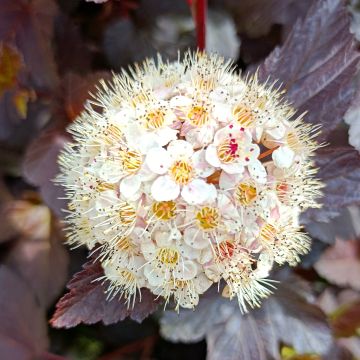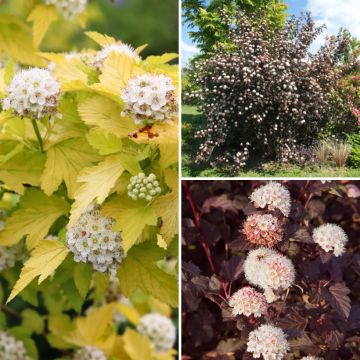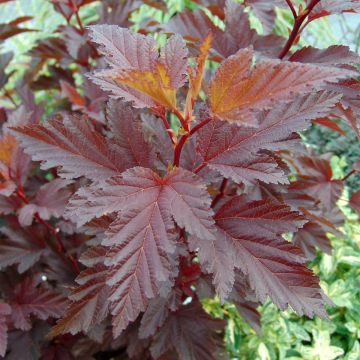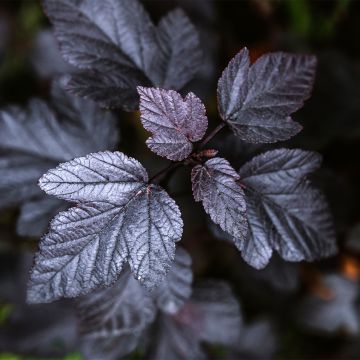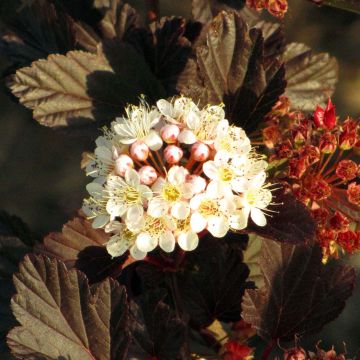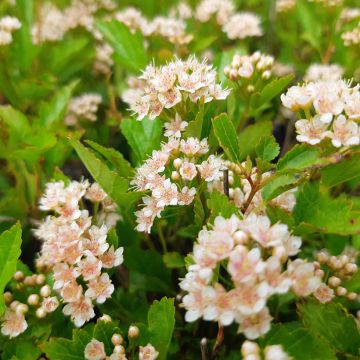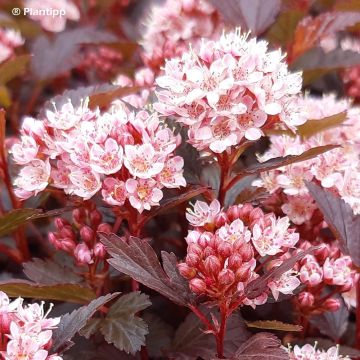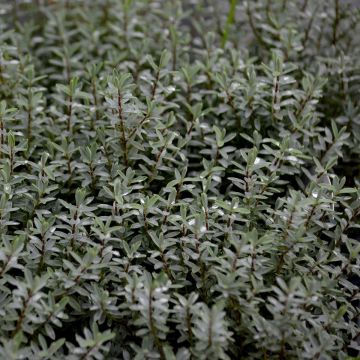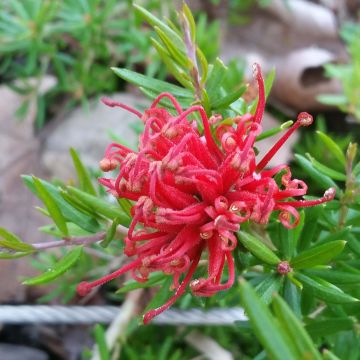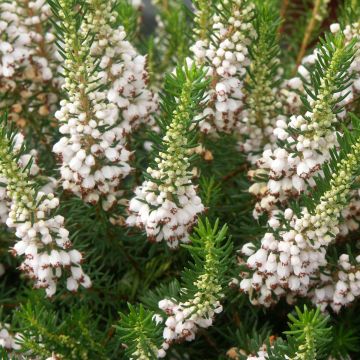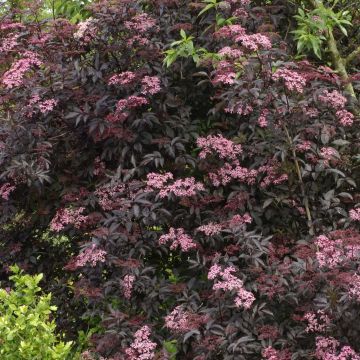

Physocarpus opulifolius Choco Flame - Ninebark


Physocarpus opulifolius Choco Flame - Ninebark
Physocarpus opulifolius Choco Flame - Ninebark
Physocarpus opulifolius Choco Flame
Ninebark, Eastern ninebark
Why not try an alternative variety in stock?
View all →This plant carries a 24 months recovery warranty
More information
We guarantee the quality of our plants for a full growing cycle, and will replace at our expense any plant that fails to recover under normal climatic and planting conditions.
From €5.90 for pickup delivery and €6.90 for home delivery
Express home delivery from €8.90.
Does this plant fit my garden?
Set up your Plantfit profile →
Description
The Physocarpus opulifolius 'Choco Flame' is a variety of Physocarpus opulifolius that stands out for the unique colour of its foliage. It displays a bronze hue, which, in young shoots, is tinged with gold in the centre, creating a bold and new contrast. Of medium size, the bush branches spontaneously and has dense vegetation. The spring flowering in corymbs of small white flowers stands out against the dark background of the foliage. In summer, decorative red fruits succeed the flowers. Easy to grow, it only fears excessive limestone or pronounced drought. Perfect for small gardens, where it can also be grown in a container on a terrace, it integrates well in a mixed border as well as in a lively hedge.
Physocarpus is a member of the large and important family of Rosaceae, which includes most of our temperate climate fruit trees (Pear, Apple, Cherry, Peach...), many wild plants from our countryside (Cinquefoil, Burnet...) and many ornamental plants (Firethorn, Cherry...). The name of the plant comes from the Greek physa (bladder) and karpos (fruit) because its fruits are vesicular follicles. Close to Spiraea and Neillia, Physocarpus stands out for its corymb flowers and its follicle fruits, grouped by 4 or 5.
There are about a dozen species of Physocarpus, including P. opulifolius native to eastern North America. It forms a vigorous shrub that can reach 3m in height, with erect to spreading branches, some of which bend down to the ground to layer, i.e. they root and give rise to a new plant from there. The green foliage turns yellow in autumn and the brown bark exfoliates, reinforcing the plant's decorative interest. This ornamental species was introduced to Europe as early as the end of the seventeenth century, but it is only in recent years with the development of many cultivars that it has spread in our gardens.
Choco Flame is a recent horticultural variety that brings a new colour to the range of Physocarpus. The young shoots of the bush are indeed bronzed, with a golden heart that creates a unique contrast. Of medium size, it reaches 1.50m in all directions, with harmonious branching and numerous shoots. The dense vegetation takes on a homogeneous bronze colour during the season, which allows for original associations with other plants with colourful foliage. The trilobed leaves with well-visible veins have a typical and very ornamental pattern. The flowering appears in May-June, in the form of almost spherical corymbs made up of small white flowers barely 1cm in diameter. The corymbs, 4 to 5cm in diameter, are well highlighted by the foliage which forms a relatively dark background. They mainly form at the ends of the branches, thus dominating the vegetation. In summer, small decorative bright red fruits succeed the flowers, further enhancing the ornamental value of the bush. Deciduous, the leaves fall in autumn, revealing the beautiful silhouette of the plant. Easy to grow, this medium-sized Physocarpus tolerates pruning well and can also be grown in a container on a terrace.
After the varieties with green, golden, variegated, and purple foliage, the Physocarpus 'Choco Flame' stands out with its very original bronze colour. Plant it alongside shrubs such as Caryopteris clandonensis Sterling Silver, whose silver-grey foliage will elegantly complement the bronze of your Physocarpus. Its flowering, of intense blue, later since it extends from August to October, will broaden the flowering period of your scene. To bring a touch of light, also install a Choysia Aztec Gold. This Mexican Orange Blossom stands out for its pleasantly cut foliage, very aromatic and of remarkable golden green. Blooming at the same time as Choco Flame, with often a second flowering in summer, it produces white flowers that exude a scent of orange blossom. And to support the Caryopteris in summer, choose a Lagerstroemia Dynamite: its intense cherry red flowering lasts all summer, from July to October, while its foliage oscillates between red when it emerges, dark green to slightly purple in season before turning red in autumn.
Report an error about the product description
Plant habit
Flowering
Foliage
Botanical data
Physocarpus
opulifolius
Choco Flame
Rosaceae
Ninebark, Eastern ninebark
Cultivar or hybrid
Other Physocarpus
Planting and care
Plant Physocarpus opulifolius 'Choco Flame' in deep, humus-bearing, rich and not too dry soil, preferably neutral to acidic. It fears excessive limestone, long dry periods, and languishes in poor soils. Dig a hole 50 by 50 cm and add compost-enriched soil to the bottom, mixing it with the existing soil. Soak the root ball in a bucket of water for fifteen minutes (until no more bubbles rise to the surface), plant it in the hole, backfill, and then water abundantly. Water regularly for the first two years and during dry summers. Once well-rooted, this Physocarpus is relatively resistant to water shortage (in not too hot climates, however).
This bush will thrive in partial shade or full sun, but the foliage colours will be more pronounced if planted in a sunny location. Thin out dense plants by pruning severely some of the arching stems after flowering. This may encourage the development of new flower buds at the end of summer. Prune back hard in spring, close to the stump, to give it a denser appearance.
Planting period
Intended location
Care
This item has not been reviewed yet - be the first to leave a review about it.
Striking foliage shrubs
Haven't found what you were looking for?
Hardiness is the lowest winter temperature a plant can endure without suffering serious damage or even dying. However, hardiness is affected by location (a sheltered area, such as a patio), protection (winter cover) and soil type (hardiness is improved by well-drained soil).

Photo Sharing Terms & Conditions
In order to encourage gardeners to interact and share their experiences, Promesse de fleurs offers various media enabling content to be uploaded onto its Site - in particular via the ‘Photo sharing’ module.
The User agrees to refrain from:
- Posting any content that is illegal, prejudicial, insulting, racist, inciteful to hatred, revisionist, contrary to public decency, that infringes on privacy or on the privacy rights of third parties, in particular the publicity rights of persons and goods, intellectual property rights, or the right to privacy.
- Submitting content on behalf of a third party;
- Impersonate the identity of a third party and/or publish any personal information about a third party;
In general, the User undertakes to refrain from any unethical behaviour.
All Content (in particular text, comments, files, images, photos, videos, creative works, etc.), which may be subject to property or intellectual property rights, image or other private rights, shall remain the property of the User, subject to the limited rights granted by the terms of the licence granted by Promesse de fleurs as stated below. Users are at liberty to publish or not to publish such Content on the Site, notably via the ‘Photo Sharing’ facility, and accept that this Content shall be made public and freely accessible, notably on the Internet.
Users further acknowledge, undertake to have ,and guarantee that they hold all necessary rights and permissions to publish such material on the Site, in particular with regard to the legislation in force pertaining to any privacy, property, intellectual property, image, or contractual rights, or rights of any other nature. By publishing such Content on the Site, Users acknowledge accepting full liability as publishers of the Content within the meaning of the law, and grant Promesse de fleurs, free of charge, an inclusive, worldwide licence for the said Content for the entire duration of its publication, including all reproduction, representation, up/downloading, displaying, performing, transmission, and storage rights.
Users also grant permission for their name to be linked to the Content and accept that this link may not always be made available.
By engaging in posting material, Users consent to their Content becoming automatically accessible on the Internet, in particular on other sites and/or blogs and/or web pages of the Promesse de fleurs site, including in particular social pages and the Promesse de fleurs catalogue.
Users may secure the removal of entrusted content free of charge by issuing a simple request via our contact form.
The flowering period indicated on our website applies to countries and regions located in USDA zone 8 (France, the United Kingdom, Ireland, the Netherlands, etc.)
It will vary according to where you live:
- In zones 9 to 10 (Italy, Spain, Greece, etc.), flowering will occur about 2 to 4 weeks earlier.
- In zones 6 to 7 (Germany, Poland, Slovenia, and lower mountainous regions), flowering will be delayed by 2 to 3 weeks.
- In zone 5 (Central Europe, Scandinavia), blooming will be delayed by 3 to 5 weeks.
In temperate climates, pruning of spring-flowering shrubs (forsythia, spireas, etc.) should be done just after flowering.
Pruning of summer-flowering shrubs (Indian Lilac, Perovskia, etc.) can be done in winter or spring.
In cold regions as well as with frost-sensitive plants, avoid pruning too early when severe frosts may still occur.
The planting period indicated on our website applies to countries and regions located in USDA zone 8 (France, United Kingdom, Ireland, Netherlands).
It will vary according to where you live:
- In Mediterranean zones (Marseille, Madrid, Milan, etc.), autumn and winter are the best planting periods.
- In continental zones (Strasbourg, Munich, Vienna, etc.), delay planting by 2 to 3 weeks in spring and bring it forward by 2 to 4 weeks in autumn.
- In mountainous regions (the Alps, Pyrenees, Carpathians, etc.), it is best to plant in late spring (May-June) or late summer (August-September).
The harvesting period indicated on our website applies to countries and regions in USDA zone 8 (France, England, Ireland, the Netherlands).
In colder areas (Scandinavia, Poland, Austria...) fruit and vegetable harvests are likely to be delayed by 3-4 weeks.
In warmer areas (Italy, Spain, Greece, etc.), harvesting will probably take place earlier, depending on weather conditions.
The sowing periods indicated on our website apply to countries and regions within USDA Zone 8 (France, UK, Ireland, Netherlands).
In colder areas (Scandinavia, Poland, Austria...), delay any outdoor sowing by 3-4 weeks, or sow under glass.
In warmer climes (Italy, Spain, Greece, etc.), bring outdoor sowing forward by a few weeks.

































